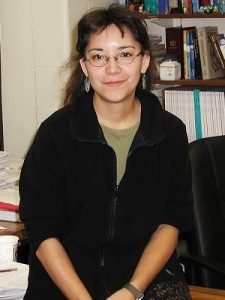
We welcome Dr. Christine Chow as our last seminar speaker of the fall semester. Dr. Chow will present her piece on Tools for Monitoring RNA Modifications and Drug Interactions at 3:00 p.m. Friday, via Zoom.
Abstract: Among different RNA modifications, the helix 69 (H69) region of the bacterial ribosomal RNA (rRNA) contains three pseudouridines (Ψs). H69 is functionally important due to its location in the heart of the ribosome. Several structural and functional studies have shown the importance of Ψ modifications in influencing the H69 conformation as well as maintaining key interactions in the ribosome during protein synthesis. Therefore, a need exists to understand the influence of modified nucleosides on conformational dynamics of the ribosome under solution conditions that mimic the cellular environment. We have used a variety of methods including fluorescence spectroscopy and chemical probing with dimethyl sulfate (DMS) to examine H69 conformational states and the influence of Ψ modifications under varying solution conditions in the context of model RNAs, ribosomal subunits, and full ribosomes. The use of DMS footprinting, electrospray ionization mass spectrometry, and fluorescence spectroscopy to study the binding of aminoglycosides to H69 as well as helix 44 of bacterial rRNA as antibiotic targets will also be discussed. As highlighted in our work, DMS probing and footprinting are versatile techniques that can be used to gain important insight into RNA local structure and RNA-drug interactions.
Bio: My group studies large RNAs in order to better understand the impacts of modifications, determine how drugs locate their preferred binding sites, and identify new drug target sites. We use a combination of synthetic, biochemical, bioinorganic, and biophysical techniques, including modified oligonucleotide synthesis, chemical modification of RNA and primer extension assays, phage display, mass spectrometry, and circular dichroism, fluorescence, and NMR spectroscopies. I have a broad background in nucleic acid chemistry, with specific expertise in modified ribosomal RNAs and small molecule-RNA interactions. To help prepare students for professional success after graduate school, I have been involved with the NIH-supported WSU Broadening Experiences in Scientific Training program (BEST, co-PI from 2013-2018 and PI2018-2019). My role was to develop seminar and workshop content for 7 different modules in business, communication, community engagement, government, law, research administration, and teaching), which involved two-hour seminars and all-day workshops with alumni, business partners, and experts in the various career tracks. I also initiated the “Mini-BEST” program at Wayne State, in which faculty in departments, centers, and cross-disciplinary programs across the campus were given guidance on how to establish their own career development events (funded by the Wayne State Graduate School). The BEST program has served more than 1000 students at Wayne State University since 2013. In 2012, I helped develop and run a campus-wide “Fellowship Writing Bootcamp”, which guided graduate students and postdocs in preparing F31/F32 applications (2012–2017). The workshop included mock study panels and recruitment of faculty to serve as reviewers of the proposals prior to submission. I also initiated the use of mock study section panels for faculty across three colleges (Liberal Arts & Sciences, Engineering, and School of Medicine).